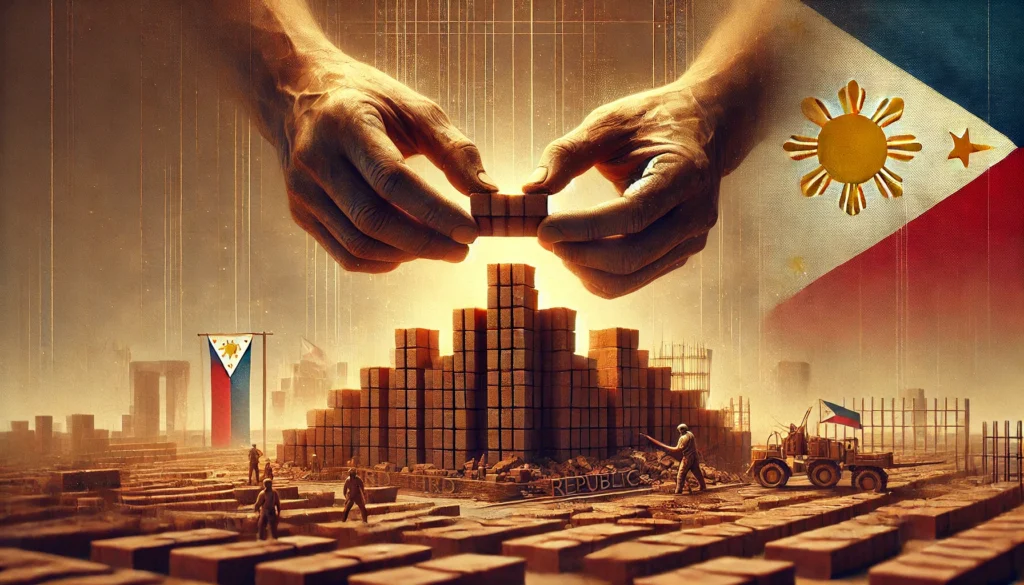The Third Republic of the Philippines emerged from the ashes of World War II, marking a new era in the nation’s history. On July 4, 1946, the United States formally recognized Philippine independence, ushering in a period of sovereignty and self-governance. This momentous occasion was the culmination of decades of struggle for freedom and set the stage for the challenges that lay ahead in building a newly independent nation.
The Transfer of Power
The transition from colonial rule to independence was not without its complexities. The United States, which had governed the Philippines since 1898, played a significant role in shaping the new republic’s political landscape. The Tydings-McDuffie Act of 1934 had set the groundwork for this transition, providing for a ten-year commonwealth period before full independence. This period allowed for the gradual transfer of power and the establishment of key institutions necessary for self-governance.
Constitutional Framework
The 1935 Constitution, which had been in effect during the Commonwealth period, continued to serve as the fundamental law of the land in the Third Republic. This document, modeled largely on the U.S. Constitution, established a presidential system of government with three branches: executive, legislative, and judicial. It also enshrined key principles such as the separation of powers, checks and balances, and the protection of individual rights.
Economic Challenges and Reconstruction
The newly independent Philippines faced enormous economic challenges in the aftermath of World War II. The country’s infrastructure had been devastated by the conflict, with major cities like Manila reduced to rubble. Agricultural production, the backbone of the economy, had been severely disrupted. The task of rebuilding the nation’s economy was daunting and required significant resources and strategic planning.
The Bell Trade Act and Economic Dependencies
One of the most contentious issues in the early years of the Third Republic was the Bell Trade Act of 1946. This U.S. legislation provided for preferential trade relations between the two countries but came with strings attached:
- Free trade between the U.S. and Philippines for 8 years, followed by gradually increasing tariffs
- Parity rights for U.S. citizens in the exploitation of Philippine natural resources
- Pegging of the Philippine peso to the U.S. dollar
While the act provided some economic benefits, many Filipinos viewed it as an infringement on their sovereignty and a continuation of economic dependence on the United States.
Agrarian Reform and Land Distribution
Land reform was a critical issue in the post-war Philippines. The concentration of land ownership in the hands of a few elites had long been a source of social and economic inequality. The government of President Manuel Roxas initiated efforts to address this issue through the creation of the Land Settlement and Development Corporation (LASEDECO) in 1950. However, progress was slow, and land reform would remain a contentious issue for decades to come.
Political Stability and Governance
The Third Republic faced significant challenges in establishing stable and effective governance. The transition from colonial rule to self-governance required the development of strong democratic institutions and a political culture that could withstand internal and external pressures.
The Two-Party System
The political landscape of the Third Republic was dominated by two major parties:
- The Nacionalista Party
- The Liberal Party
This two-party system, while providing some stability, also led to intense political rivalries and, at times, hindered the development of alternative political voices.
Corruption and Patronage Politics
One of the persistent challenges faced by the Third Republic was the issue of corruption and patronage politics. The concentration of power in the hands of political elites and the persistence of clientelistic relationships between politicians and voters undermined efforts to establish transparent and accountable governance.
Security Challenges and Internal Conflicts
The Third Republic faced significant security challenges, both internal and external, which threatened the stability of the young nation.
The Hukbalahap Rebellion
One of the most serious internal conflicts of the early Third Republic was the Hukbalahap Rebellion. The Hukbalahap (People’s Anti-Japanese Army) had been a resistance movement during World War II. In the post-war period, many of its members, disillusioned with the slow pace of social reforms and land redistribution, took up arms against the government.
| Year | Major Events in the Hukbalahap Rebellion |
|---|---|
| 1946 | Hukbalahap reorganizes as Hukbong Mapagpalaya ng Bayan (HMB) |
| 1950 | Rebellion reaches its peak, controlling large areas in Central Luzon |
| 1954 | Rebellion largely suppressed under the Magsaysay administration |
The government’s response to the rebellion included both military action and social reforms, with the latter approach proving more effective in the long term.
External Security Concerns
The Philippines, as a newly independent nation, had to navigate complex international relations in the context of the Cold War. The country aligned itself closely with the United States, signing the Mutual Defense Treaty in 1951. This alliance provided security guarantees but also tied the Philippines to U.S. foreign policy objectives in the region.
Social and Cultural Challenges
The Third Republic grappled with the task of forging a unified national identity while respecting the country’s diverse cultural and linguistic heritage.
Language Policy and National Identity
The question of national language was a contentious issue. While English remained widely used in government and education, efforts were made to promote Filipino (based on Tagalog) as the national language. This policy faced resistance from speakers of other Philippine languages who felt marginalized by the emphasis on Tagalog.
Education and Nation-Building
Education played a crucial role in the nation-building efforts of the Third Republic. The government invested heavily in public education, seeing it as a means to promote national unity, develop human capital, and foster economic development. However, challenges remained in terms of access to education, particularly in rural areas, and in the quality of instruction.
Economic Development and Industrialization
The Third Republic saw significant efforts to modernize the Philippine economy and reduce dependence on agricultural exports.
Import Substitution Industrialization
In the 1950s and 1960s, the Philippines, like many developing countries, adopted a policy of import substitution industrialization (ISI). This approach aimed to reduce reliance on imported goods by developing domestic industries.
Key features of the ISI policy:
- High tariffs on imported manufactured goods
- Government support for domestic industries
- Focus on producing consumer goods for the domestic market
While this policy led to some industrial growth, it also resulted in inefficiencies and a lack of international competitiveness in many sectors.
The Green Revolution
In the agricultural sector, the Philippines embraced the Green Revolution of the 1960s and 1970s. This involved the adoption of new high-yielding varieties of rice, increased use of fertilizers and pesticides, and improved irrigation systems. While these innovations led to significant increases in agricultural productivity, they also had environmental and social consequences that would become apparent in later years.
Foreign Relations and Diplomacy
The Third Republic had to navigate a complex international landscape, balancing its close relationship with the United States with efforts to assert its independence and engage with other nations.
Relations with the United States
The Philippines maintained close ties with the United States throughout the Third Republic period. Key aspects of this relationship included:
- The Mutual Defense Treaty of 1951
- The presence of U.S. military bases (Clark Air Base and Subic Bay Naval Base)
- Significant U.S. economic and military aid
While this relationship provided benefits in terms of security and economic assistance, it also led to criticism that the Philippines was overly dependent on its former colonial power.
Regional Engagement
The Philippines was a founding member of the Association of Southeast Asian Nations (ASEAN) in 1967. This marked an important step in the country’s engagement with its regional neighbors and its efforts to play a more active role in Southeast Asian affairs.
Environmental Challenges and Natural Disasters
The Philippines, due to its geographical location, faced significant environmental challenges and natural disasters during the Third Republic period.
Deforestation and Resource Exploitation
The rapid exploitation of the country’s natural resources, particularly its forests, became a significant issue during this period. Deforestation, driven by logging, agricultural expansion, and population growth, led to environmental degradation and increased vulnerability to natural disasters.
Typhoons and Natural Calamities
The Philippines’ location in the Pacific typhoon belt meant that it regularly faced destructive storms. Some notable typhoons during the Third Republic period include:
| Year | Typhoon Name | Impact |
|---|---|---|
| 1947 | Typhoon Clara | Over 300 deaths |
| 1970 | Typhoon Yoling | Over 600 deaths, significant damage to Manila |
| 1984 | Typhoon Ike (Nitang) | Over 1,300 deaths |
These natural disasters posed significant challenges to the government’s disaster response capabilities and often had long-lasting impacts on affected communities.
The End of the Third Republic
The Third Republic came to an end with the declaration of martial law by President Ferdinand Marcos on September 21, 1972. This marked the beginning of a period of authoritarian rule that would last until 1986.
Factors Leading to Martial Law
Several factors contributed to the declaration of martial law:
- Growing social unrest and student protests
- Perceived threat of communist insurgency
- Economic challenges and rising inequality
- Marcos’s desire to extend his rule beyond the constitutional limit
The imposition of martial law fundamentally altered the political landscape of the Philippines and marked the end of the democratic experiment that had begun with independence in 1946.
Legacy of the Third Republic
The Third Republic, despite its challenges and ultimate demise, left a significant legacy in Philippine history. It represented the first sustained period of self-governance and democratic rule in the country. The institutions established during this period, though imperfect, provided the foundation for future democratic developments.
Key Achievements:
- Establishment of democratic institutions
- Economic development and industrialization efforts
- Expansion of public education
- Assertion of Philippine sovereignty in international affairs
Persistent Challenges:
- Economic inequality and underdevelopment
- Corruption and patronage politics
- Internal security threats
- Environmental degradation
The experiences of the Third Republic continue to shape Philippine politics and society to this day, offering both lessons and cautionary tales for the ongoing process of nation-building.
Disclaimer: This article aims to provide an accurate and comprehensive overview of the Third Republic of the Philippines. However, given the complexity of historical events and ongoing scholarly debates, some interpretations may be subject to differing views. Readers are encouraged to report any inaccuracies or provide additional perspectives for review and potential updates to ensure the continued accuracy and relevance of this content.




